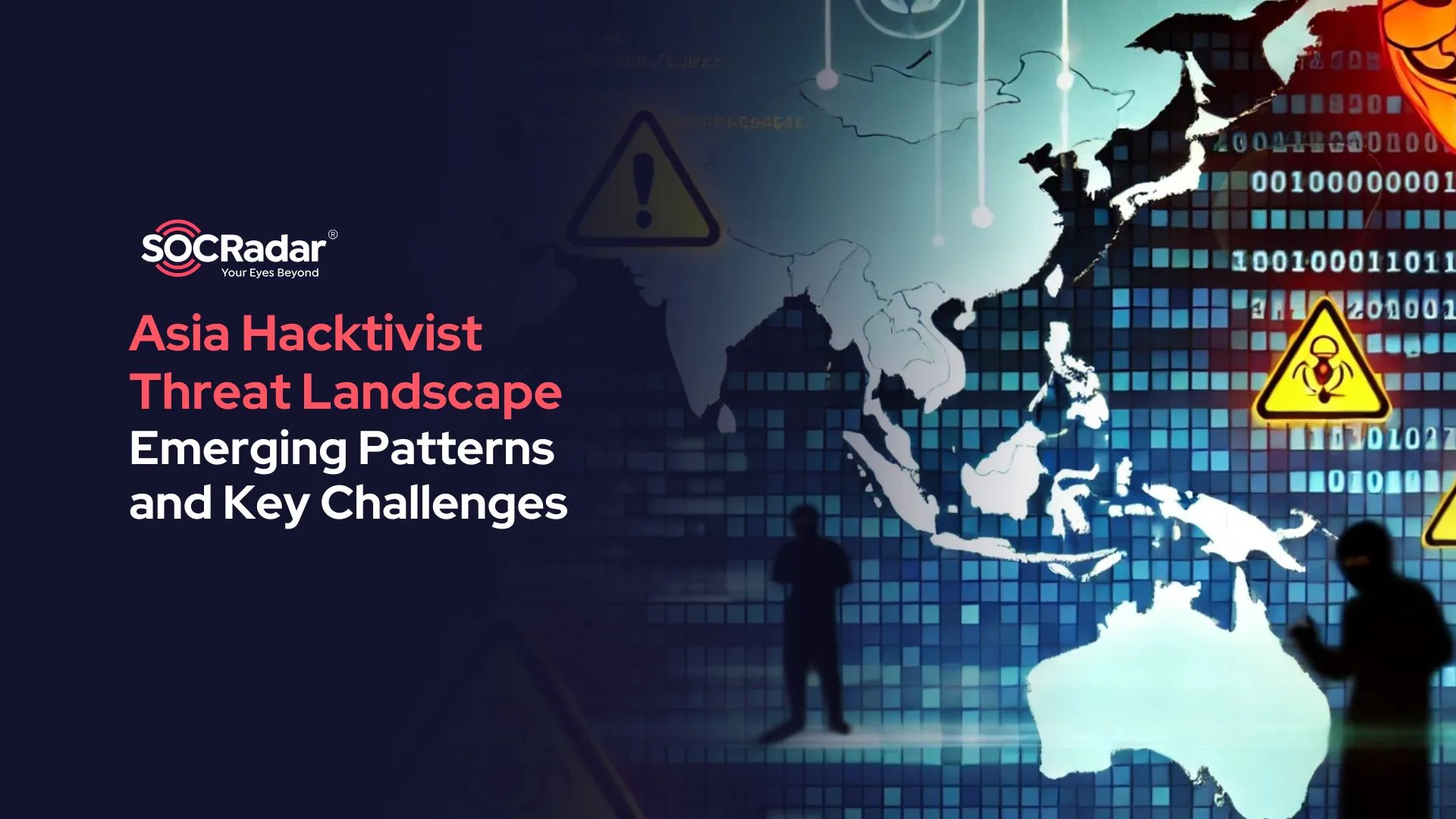
Asia Hacktivist Threat Landscape
Hacktivism blurs the lines between digital rebellion and activism, as threat actors act for their social and political causes.
Far from the traditional protest, hacktivism unfolds in the digital arena, where unauthorized access, data breaches, and website defacements become weapons of dissent. With these disruptive tactics, hacktivists aim to expose perceived injustices on issues important to them that often go ignored.
Their targets are frequently government institutions, corporations, and organizations they accuse of ethical, social, or political wrongdoings.
In this article, we’ll dig into into the world of Asia’s hacktivist groups—exploring their motivations, methods, and the powerful messages they aim to send.
Motivations of Hacktivists in Asia
Asian hacktivists are driven by various motivations, primarily categorized into religious and political factors. These motivations shape their targets, methods, and the overall impact of their activities.
When we look at their actions and statements, we can indicate that religion seems to be more important than politics for them.
Religious Motivations
Asia is the most religiously diverse continent, home to many of the world’s major religions, including Hinduism, Buddhism, Islam, Sikhism, and Jainism, as well as other belief systems and traditional practices. Religious motivations play a significant role in the actions of various hacktivist groups across Asia. Muslim groups, especially, often view their digital activities as a form of digital jihad, where they leverage technology to promote their religious ideologies or retaliate against perceived insults to their faith.
For instance, Team Insane PK, a prominent hacktivist group based in Pakistan, has been involved in numerous cyberattacks against Indian entities, framing their actions within a religious context. Their operations often include Distributed Denial of Service (DDoS) attacks aimed at Indian businesses and government websites, accompanied by messages that reflect their religious beliefs.

Telegram channel of Team Insane Pakistan, monitored by SOCRadar
Similarly, Anonymous Sudan, another notable hacktivist collective, has targeted countries like Sweden and Denmark in response to incidents perceived as disrespectful to Islam, such as the burning of the Quran. Their campaigns are characterized by a strong religious undertone, aiming to defend Islamic values and retaliate against those they see as offenders.
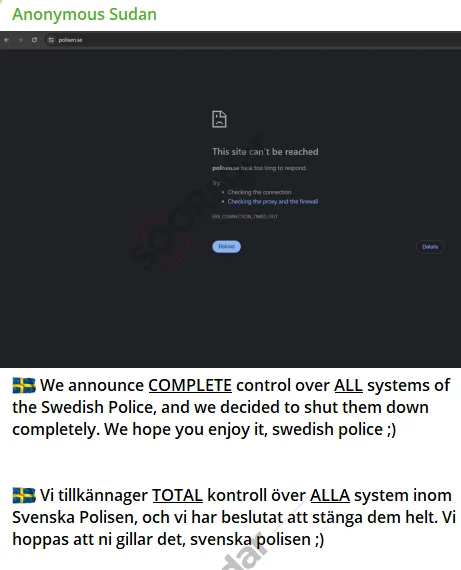
The Telegram channel of Anonymous Sudan, monitored by SOCRadar
In the Telegram message above, the threat actor group Anonymous Sudan has made allegations regarding a potential cyberattack against the Swedish Police. The group claimed to have gained “COMPLETE control over ALL systems” of the law enforcement agency and announced their intention to “shut them down completely.”
Political Motivations
Political motivations are another influential factor in shaping the activities of Asian hacktivists. Hacktivism in Asia is significantly influenced by local, regional, and international political dynamics.
Many groups engage in cyber operations as a response to governmental actions or policies they view as oppressive or unjust. These influences manifest through various issues, including religious tensions and social movements.
Territorial disputes also fuel patriotic groups’ anger. These threat actors may engage in cyber operations to express nationalistic sentiments or retaliate against perceived injustices related to territorial claims.
Additionally, political tensions often serve as catalysts for hacktivist activity. For instance, during times of geopolitical unrest, various hacktivist collectives may unite under common causes to target governments or organizations associated with oppression or conflict.
The Philippines has witnessed a form of hacktivism linked to social movements opposing government corruption and authoritarianism. Threat actors like ph1ns have shared posts related to their malicious actions against government agencies or private companies to protest policies or actions deemed unjust. This threat actor tagged some of their posts with the #OpEDSA tag to show the reason behind their attack and their stance.

A post from a Dark Web forum monitored by SOCRadar
You can learn about the latest Dark Web developments with SOCRadar’s Dark Web News module. SOCRadar’s Dark Web News page revolutionizes how you stay informed. It’s not just an information aggregator; it’s a sophisticated filter, meticulously separating the signal from the noise.
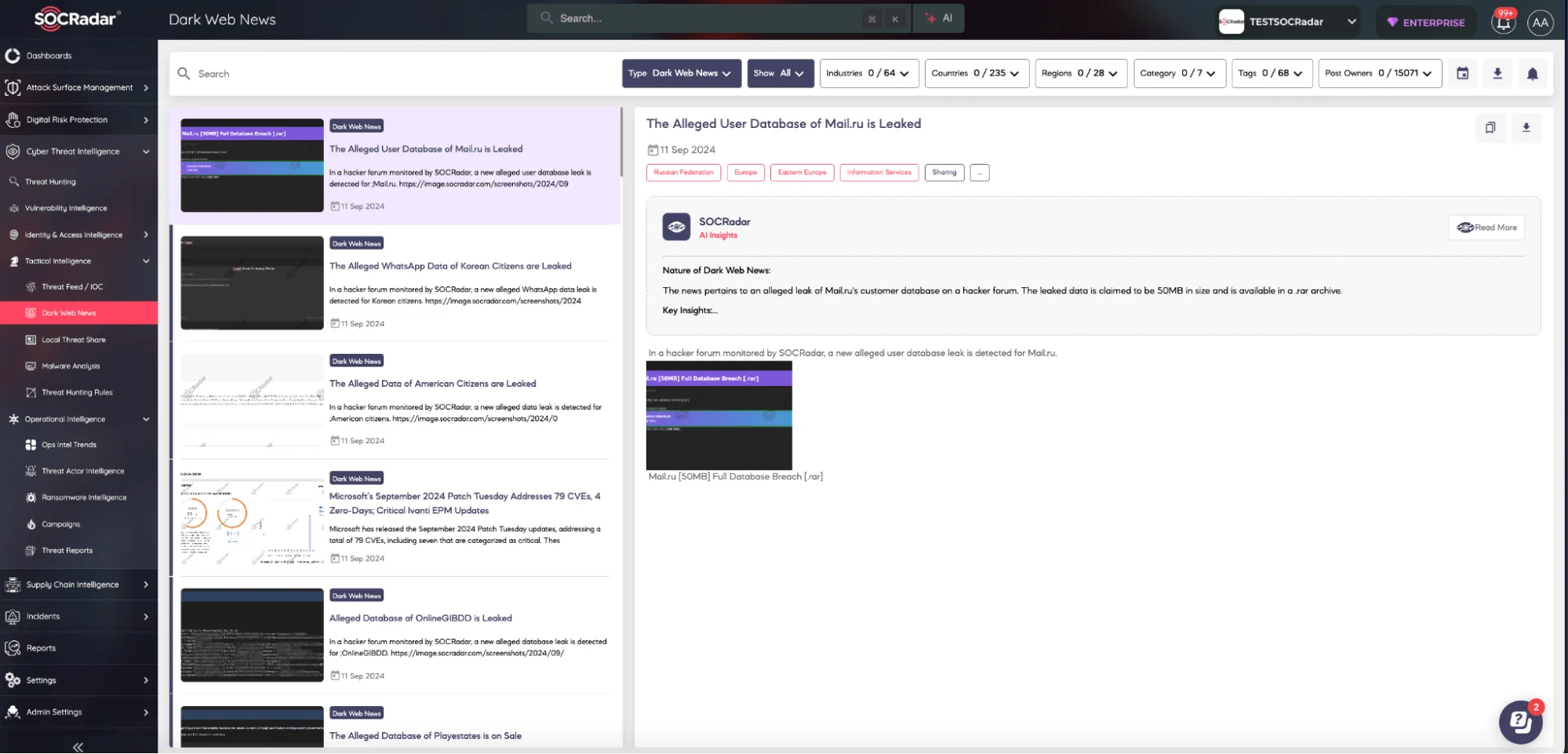
SOCRadar’s Dark Web News module
Regional Division of Asian Hacktivists
Hacktivists in Asia generally accumulated into two sub-regions. In South Asia, hacktivist groups in countries like India, Pakistan, and Bangladesh are notable for their politically charged motivations. These groups often engage in cyberattacks targeting government agencies, media outlets and other private organizations with statements reflecting regional tensions and long standing rivalries. Most of these hacktivists act with political motivations.
In Southeast Asia, hacktivism trends in nations like Indonesia, Malaysia, and the Philippines are heavily shaped by religion. Activists in these countries frequently conduct cyber campaigns aimed at government entities they see as enemies and organizations they see as conflicting with their beliefs.
Analyzing Asian Hacktivists’ Activities
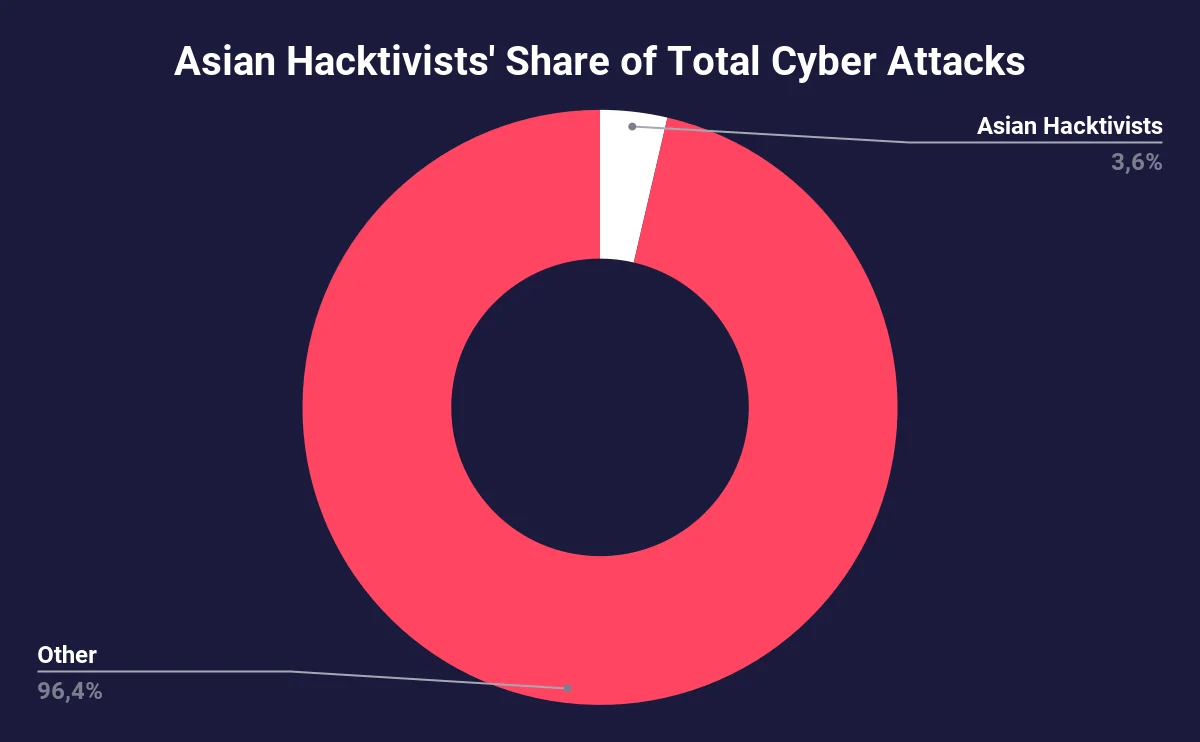
Activities of Asian hacktivists compared to every other type of malicious cyber activity
SOCRadar is tracking numerous Asian hacktivist groups and recording their activities in the Advanced Dark Web Monitoring module. In analyzing the cyber threat landscape of the past year, a striking disparity emerges between Asian hacktivists and other threat actors. Asian hacktivists accounted for 3.6% of total cyberattacks, highlighting their position in the broader spectrum of cyber activities. Considering the cyber threat landscape, approximately 4% of the attacks coming from one point is noteworthy.
In stark contrast, 96.4% of attacks were attributed to various other threat actors, encompassing a diverse range of motivations, from financial gain to espionage and beyond (including hacktivism, but from other regions).
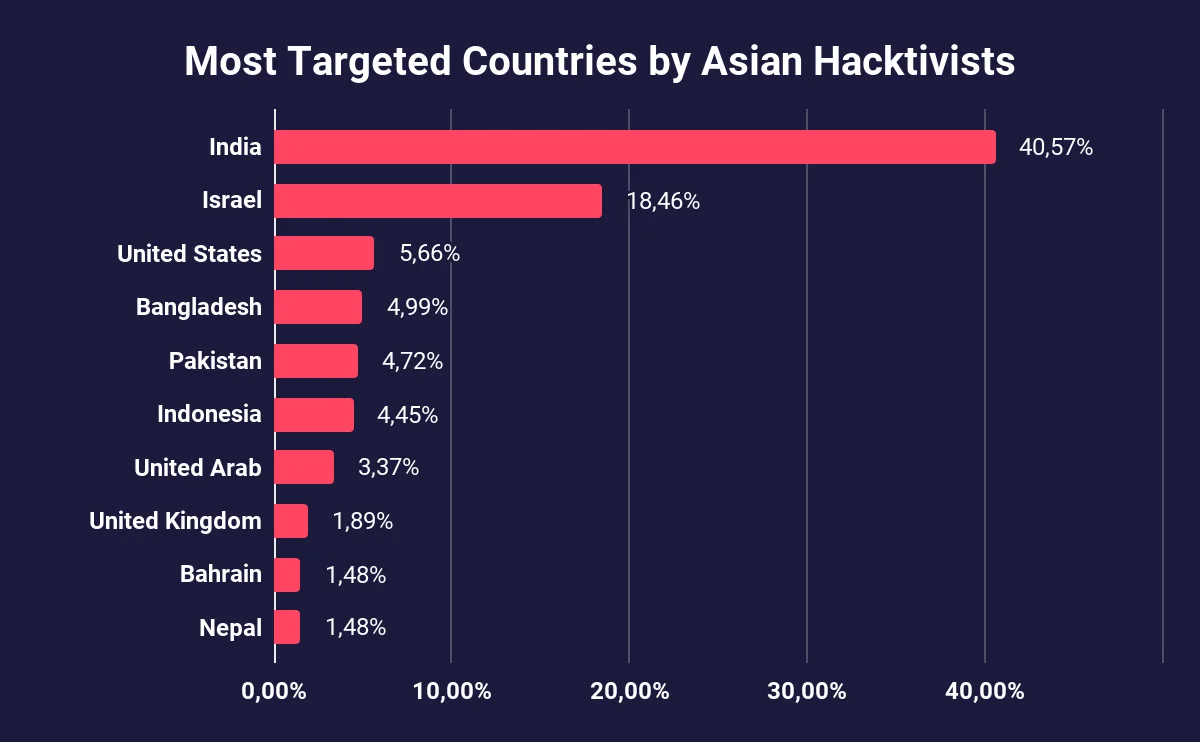
Countries most targeted by Asian Hacktivists
The data highlights the impact of hacktivist-driven cyberattacks on India, Israel, and the United States, with motivations likely rooted in sociopolitical and religious tensions.
India, bearing the highest impact rate at 40.57%, may be targeted due to its historical and ongoing conflicts affecting Muslim communities, which have fueled resentment among certain groups.
India’s relationship with its Muslim population is shaped by a long, complex history marked by both periods of coexistence and conflict. Since the 1947 Partition, Hindu-Muslim tensions have occasionally erupted into violence, fueled by historical grievances and modern political divides.
In recent years, under Prime Minister Narendra Modi’s BJP government, concerns have grown about Hindu nationalist policies that Muslims feel target them unfairly. Other issues, such as vigilante violence, socio-economic disparities, and restrictions on religious practices, have deepened this sense of insecurity.
India is not the only country experiencing various frictions with the Muslim community, but because it is located in the region, these issues resonate more with hacktivists in Asia.
India’s stance during the Hamas-Israel conflict can be another reason for the negativity towards them.
Israel, with an impact rate of 18.46%, is experiencing a surge in hacktivist attention, likely connected to recent events surrounding the Hamas-Israel conflict, intensifying hacktivist efforts from those sympathizing with Palestinian causes.
The United States, impacted at a rate of 5.66%, faces hacktivist actions primarily due to its geopolitical alliances and policies in the region. Considering the low numbers for the USA, it’s possible that hacktivists prioritize targets based on the immediacy of their political or social grievances, concentrating their efforts on regions where their messages might resonate more strongly.
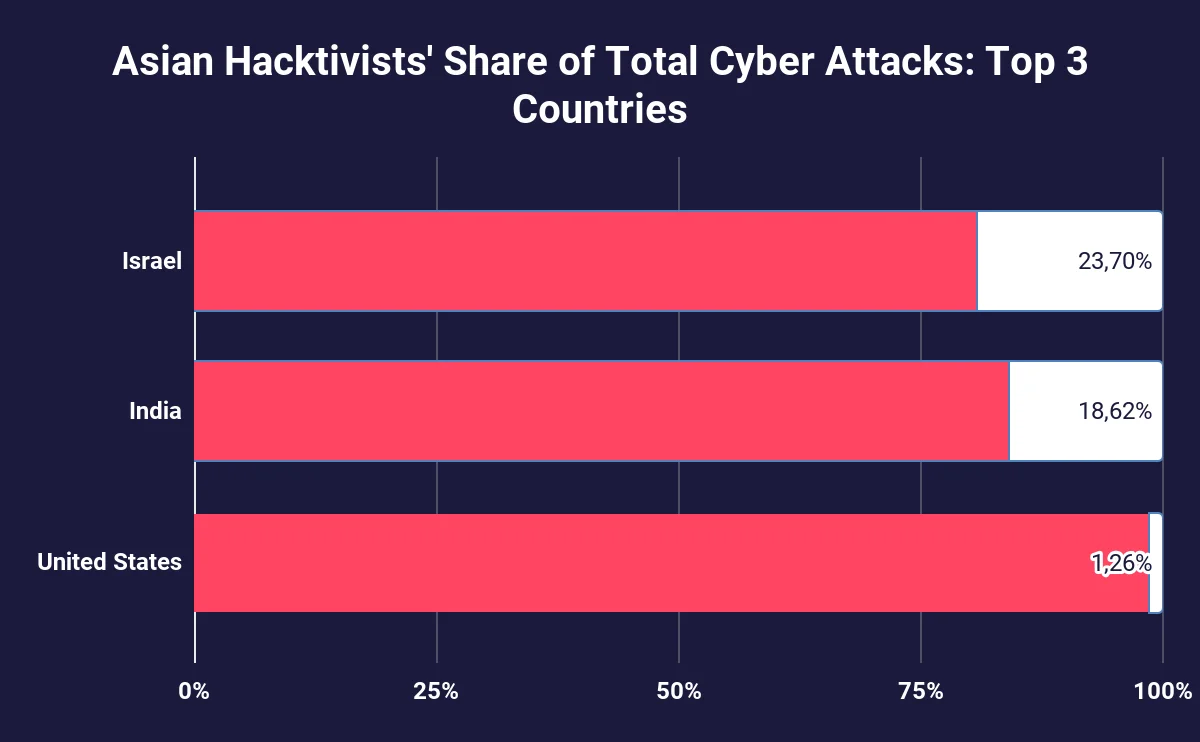
The share of Asian Hacktivists’ activities among all the attacks these countries face with
While Asian hacktivist activity is predominantly directed at India as we showed in the earlier graph, these attacks pose a more significant challenge for Israel. Hacktivists’ actions take approximately 18.62% of all the cyber attacks targeting India. However, for authorities in Israel, Asian hacktivists occupy a larger portion of their focus. 23.70% of the malicious cyber activities targeting Israel come from Asian hacktivists.
In contrast, the United States sees a relatively minimal focus, with only 1.26% of the malicious actions belonging to Asian hacktivists. Given the actions of hacktivist groups and the broader cyber ecosystem across the three countries, it appears unlikely that the United States is targeted less frequently solely due to its advanced security measures. This lower percentage could indicate that while the U.S. is a major player in the global cyber arena, it is currently not the primary focus for Asian hacktivists, who may prioritize their efforts on countries closer to the heart of the conflict or where their actions can resonate more significantly within the context of local socio-political dynamics.
Conclusion
In conclusion, Asian hacktivist groups frequently engage in cyberattacks rooted in religious motivations and local conflicts. Rather than pursuing global campaigns, these groups typically focus on perceived adversaries close to home, including governments, institutions, and organizations they associate with religious or political grievances. This targeting reflects a distinct trend: hacktivist operations in Asia are often shaped by regional disputes and a desire to address specific, local issues. Such activities highlight the significance of understanding how local dynamics influence cyber threats and the unique motivations driving these groups within the broader hacktivist landscape.
In addition to local problems, they also target the main entity related to religious or political problems, as in the case of Israel or Sweden.
Since hacktivists need the public, they often share their activities via various channels. Check SOCRadar Advanced Dark Web monitoring to see if any threat actor is talking about your organization on Dark Web forums or Telegram channels.



































